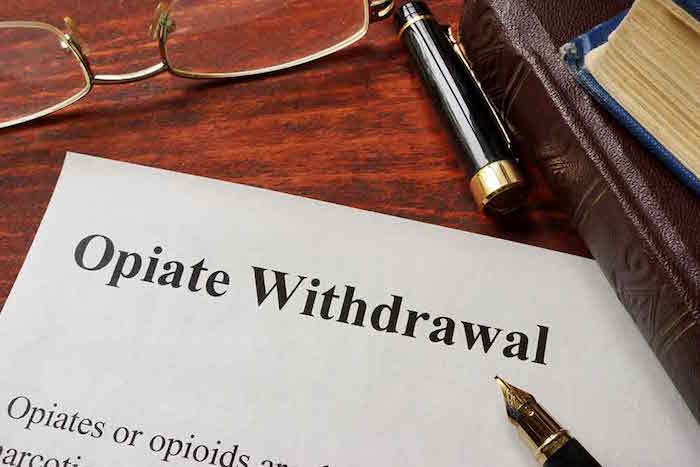Read the latest and greatest from our team
of incredible specialists.

Beach House Recovery Center » Blog » Opiate Withdrawal Timeline to Detox & Expectations
An opiate addiction develops when your brain develops a dependence on drugs to feel good. Opiates and opioids include several drugs that are typically prescribed for pain management. Opioids include oxycodone (OxyContin®), hydrocodone (Vicodin®), heroin, and others. Opiates (natural substances directly derived from the opium poppy) include codeine, morphine, narcotine, and many others. If taken in larger doses than prescribed or for longer than prescribed, the brain’s natural production of “feel-good” transmitters will decrease and its dependence on synthetic drugs to produce these feelings will develop.
If you’re wondering how common this type of addiction is, two million of the 20.5 million Americans 12 or older that had a substance use disorder in 2015 had a disorder that involved prescription pain relievers. (American Society of Addiction Medicine.)
(Although opiates and opioids are not the same, opioid is a broader term, so that will be used primarily throughout this article.)

For those who wish to quit or significantly decrease the amount of the opioid they’re using, withdrawal symptoms will be their biggest challenge. There are several common opioid withdrawal symptoms that are often flu-like and may include:
The brain’s craving for the drug to combat these withdrawal symptoms are so incredibly strong that trying to quit opioids by oneself is almost impossible. Those who try to go “cold turkey” must be aware of the dangers involved. Not only is this method one of the most ineffective ways to quit, but the body may also react with convulsions and seizures if opioids are suddenly removed from the system in this manner.
The most effective and safest way to withdrawal from opioids is under the care and supervision of professionals at a medically-supervised detox center.
Overcoming an opiate addiction may not be easy, but it is possible and there is a lot of support available.
While your body is experiencing withdrawal, it is going through the detoxification process. Detox is the body’s way of removing all the toxins from the body and resetting the brain to its original state where it no longer needs synthetic opioids to produce endorphins.
The National Institute on Drug Abuse says that detoxification is the first stage of addiction treatment, and it can be a strong indicator of the effectiveness of drug addiction treatment. Additional stages for long-term recovery include physical check-ups, therapy, support, and more.
For these reasons, medically-supervised detox is preferred for those looking for a long-term treatment plan to combat drug addiction.
Opiates and opioids have a tough withdrawal process. The withdrawal process is often the biggest stumbling block for those looking to quit. However, knowing what to expect and understanding the timeline can better prepare families, caregivers, friends, and those ready to start the recovery process.
The recovery process and timeline will depend on many factors, including the severity of the drug use, the longevity of the addiction, the type of painkiller that was abused, and whether other substances were involved. However, there are enough similarities in each case that a basic outline of a withdrawal timetable has been created.
Eight to 12 hours after the last dose: Withdrawal symptoms may include cravings, anxiety, agitation, loss of appetite, fever, muscle aches, and sweating.
Days 1-3: Symptoms from above worsen, and additional symptoms may include headaches, irritation, stomach problems, insomnia, and panic attacks. Most relapses happen during this time which is why it’s critical to seek help and prepare for the withdrawal.
Days 3-5: Although the length of withdrawal symptoms may vary, most people have made it through the worst at this point. Symptoms during this time may include fatigue, shivers, minor muscle pain, and stomach cramping.
Although the physical symptoms of opiate withdrawal will subside, the recovery process continues long after the detox. Professional medical support during the initial withdrawal process will help make the individual feel as comfortable as possible as s/he undergoes the physical symptoms. Ongoing support through a professional drug rehab facility, whether it is inpatient or outpatient, is recommended to help with long-term recovery. No matter how long it takes or how difficult the withdrawal and recovery process may be, it’s absolutely worth the struggle and effort. There are people and resources available to help. This is not a journey to take alone.
Whether you’re researching for yourself or a loved one, Beach House can help. We understand that this is a serious time in your life and that the treatment center you choose matters. We want you to feel comfortable and empowered to make the right decision for yourself, a friend, or a family member. This is why a counselor is waiting and available to answer your questions and help put your mind at ease regarding the next steps. Many of the staff at Beach House have walked in your shoes. If you feel you’re ready or want more information about how to help a loved one, we can help today. You can also learn why we are voted the #1 rehab for addiction treatment in Florida.
We accept most major insurance plans and can verify your benefits quickly and confidentially.
We’re committed to helping you access the care you need, our admissions counselors can guide you through your coverage options and available resources.





"*" indicates required fields